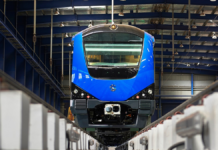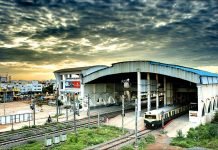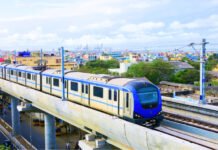CHENNAI (Metro Rail News): Chennai metro has already begun the track laying work at the Poonamallee Depot for Phase 02 of the project. Phase -02 of the project is being constructed at an estimated cost of INR 63246 Crore.
This is a major unfolding as it’s the first time that ballast test tracks are being deployed for the Chennai Metro. Even the entire Phase 2 project will have ballastless tracks except for this depot at Poonamallee.
Chennai Metro has taken this step in order to meet its priority of completing the 820m long test track along with a Stabling line and Inspection line to facilitate the driverless metros for Phase 02, arriving by August next year.
The Depot will have a total of 24 tracks, out of which 13 lines will have ballasted tracks inside the depot while 11 will have ballastless tracks outside the depot. The decision to lay the Ballast Test track has been made in order to achieve timely completion of the project under the estimated budget.
Ballast test tracks are a type of track system that consists of a layer of crushed stones, called ballast, on which the railroad ties and tracks are laid. It has got some inherent advantages like:
- Cost-Effective: Ballasted tracks are generally more cost-effective to install and maintain compared to ballastless tracks.
- Ease of Repair: Repairs and maintenance of ballasted tracks can be simpler and quicker since it’s easier to replace damaged or worn ballast and track components.
While ballasted tracks have some inherent benefits, these also offer a plethora of challenges relating to alignment, speed limitations and extensive maintenance. Owing to constant movement and weight, ballast tracks get settled with time, demanding maintenance-intensive measures. The constant movement also necessitates regular checks of alignment to ensure continuous services.
These tracks are also subject to environmental patterns like flood, erosion and freeze-thaw cycles that can lead to degradation of the ballast and track components. Since CMRL has decided to go with ballast test Tracks inside the depot, it seems to be a carefully calculated move to ensure timely completion while also keeping in mind the long-term sustainability of the project.
Phase 2 of the Chennai Metro Project pitches for a 118.9 km Network consisting of 3 corridors, namely:
- Corridor 3: Madhavaram to SIPCOT (45.8 Km)
- Corridor 4: Lighthouse to Poonamalle Bypass (26.1 Km)
- Corridor 5: Madhavaram to Sholinganallur (47 Km)
Currently, 36 out of the 61 packages, encompassing Civil, Track, and System components for Corridor 3, Corridor 4, and Corridor 5, have been granted, and construction is underway. The project is scheduled for completion by the conclusion of 2026.
Discover the endless possibilities of our city’s Metro at InnoMetro, our flagship Expo and Conference. Be an active participant in shaping its future towards a more sustainable tomorrow. Stay informed and join us to take a step towards a brighter future.






